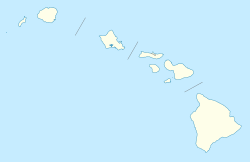Fort Ruger facts for kids
Quick facts for kids Fort Ruger |
|
|---|---|
| Part of U.S. Army Coast Artillery Corps | |
| Honolulu, Hawaiʻi | |
| Site history | |
| Built | 1906 |
| In use | 1906–present |
|
Fort Ruger Historic District
|
|
| Location | Diamond Head Rd., Honolulu, Hawaii |
|---|---|
| Built | 1911 |
| NRHP reference No. | 83000249 |
| Added to NRHP | July 14, 1983 |
Fort Ruger is an old military fort on the island of Oʻahu in Hawaiʻi. It was the very first military base in what was then called the Territory of Hawaii. The fort is named after a Civil War general, Thomas H. Ruger. It was built in and around the famous Diamond Head Crater. The United States built this fort to protect the harbor of its new territory. It started in 1906 as the Diamond Head Reservation and got its current name, Fort Ruger, in 1909.
History of Fort Ruger
Fort Ruger was home to something called Battery Harlow. This battery had eight large 12-inch mortars. These were like giant cannons that could fire shells high into the air.
Because Fort Ruger was built on Diamond Head, it was a perfect spot for a fire control station. This means it was used to direct the firing of the big guns. Several lookout posts were built right into Lēʻahi Peak.
Today, Fort Ruger is listed on the National Register of Historic Places. Parts of the fort are still used for training by the Hawaii National Guard.
Not many of the original buildings from the fort are still standing. The most interesting parts that remain are three sets of stone structures. These used to be the gates to the fort.
On the Waikiki side, you can see two stone gateposts. Across the street is a square stone bunker. It has a narrow opening for a gun and looks like a castle wall with its crenels and merlons.
On the Kahala side, there is a larger stone gatehouse. It has rounded edges, a style popular in the 1930s.
Between these two, on the Kaimuki side, is a decorative stone planter. It has two jagged stone arches that cross each other. This planter is now next to the Kapiolani Community College parking lot. It was once flanked by two large gun barrels.
Images for kids












